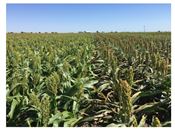Sugarcane Aphids Were Much Less Of An Issue In 2017

Susceptible sorghum plants on the left and tolerant hybrid plants on the right.
BRENT BEAN
LUBBOCK, TEXAS
Growers cite the difficulty and expense of controlling sugarcane aphids as one of the primary reasons for choosing not to grow sorghum. However, over the last couple of years, issues with sugarcane aphids have greatly diminished.
For multiple reasons, sugarcane aphids are becoming less of a problem for sorghum growers. First and foremost, growers have learned how to effectively manage this pest by using both preventative and remedial practices. Sound scouting methods and economic thresholds are in place to keep aphids under control. Effective products have been identified, and growers have learned to control aphids before they reach populations that hurt yield.
When sugarcane aphids first became an issue in many commercial fields in 2014 and 2015, few, if any, sorghum hybrids with sugarcane aphid- resistance had been identified. Today, numerous hybrids have been identified as being “tolerant” to sugarcane aphids. Although these hybrids certainly are not immune to sugarcane aphids, their widespread planting by sorghum growers has greatly lowered the population of aphids and reduced field infestation levels. The planting of a tolerant hybrid does not necessarily eliminate the need for an insecticide application, though it does reduce the potential need for multiple applications.

Choosing a hybrid that is adapted to your area and environment is important. Most of the state extension services have identified tolerant hybrids for various regions. In addition, the United Sorghum Checkoff Program publishes an updated list of hybrids that have third-party confirmation of tolerance. This list can be found on the pest management page of the United Sorghum Checkoff Program website at http://www.sorghumcheckoff.com/farmer-resources/grain-production/pest-management. Check with your seed company for specifics on adaptation of any unfamiliar hybrid. Each year, growers can expect more and better hybrids with tolerance to sugarcane aphids.
In addition, natural enemies of sugarcane aphids are evolving, creating even greater optimism in the battle against these pests. Populations of lady beetles, especially the Asian multicolored lady beetle, are growing in number. Parasitoid wasps that can successfully mummify aphids also are becoming more abundant, along with lacewings and syrphid flies. Plus, a fungus has been identified that can infect sugarcane aphids and cause the population to quickly crash. The adaptation of natural enemies to sugarcane aphids or any new pest is extremely important to long-term control. ∆
BRENT BEAN: USCP Agronomist